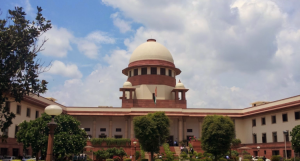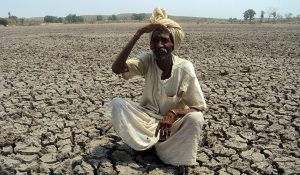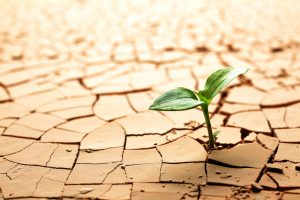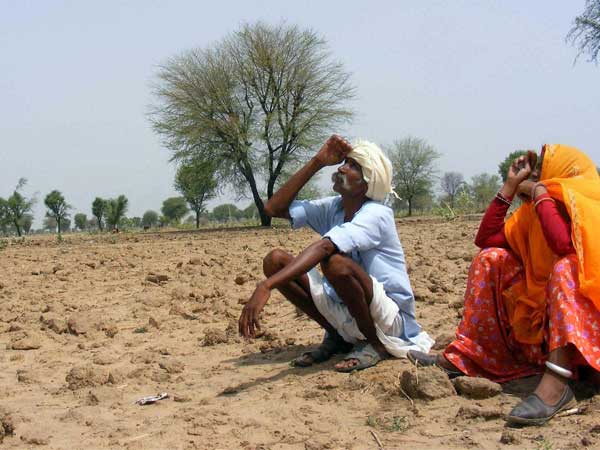Tackle Drought, Stop Disaster

Delhi’s Tamil Youth comes in support of Tamil Nadu Farmers
March 28, 2017
Waiving off farm loan to benefit UP farmers
April 5, 2017The problem is not lack of resources or capability, but the lack of will to deal with drought. With early determination of a drought, uniform standard planning to tackle disaster and serious implementation of Disaster Management Act 2005, effects of drought can be mitigated
Birjesh Singh
The recent comment made by Supreme Court pointing the absence of policy for preventing farmers’ suicides is an indicative of the fact that suicides/death of farmers remains mere statistical data for the government. The Supreme Court is currently hearing Public Interest Litigations (PIL) filed to direct the government to act on draught like situation, farmers’ suicides and agrarian distress due to it. The two separate petitions have been filed by NGO ‘Citizens Resource and Action and Initiative’, and Swaraj Abhiyan.
 Earlier a month ago, hearing a PIL filed by NGO ‘Citizens Resource and Action and Initiative’, Supreme Court emphasized the need for a comprehensive national policy to protect farmers, many of whom have committed suicide due to rising debt and crop failures caused by natural calamities. The bench comprising Chief Justice J S Khehar and Justice N V Ramana said, “It is a sensitive matter of larger public interest and human rights which covers the entire country” and therefore they expanded the scope of the petition which has raised the issue of farmers’ suicides in Gujarat, to the entire country. It also directed all states governments, Union Territories, the Centre and the RBI to assist on this issue.
Earlier a month ago, hearing a PIL filed by NGO ‘Citizens Resource and Action and Initiative’, Supreme Court emphasized the need for a comprehensive national policy to protect farmers, many of whom have committed suicide due to rising debt and crop failures caused by natural calamities. The bench comprising Chief Justice J S Khehar and Justice N V Ramana said, “It is a sensitive matter of larger public interest and human rights which covers the entire country” and therefore they expanded the scope of the petition which has raised the issue of farmers’ suicides in Gujarat, to the entire country. It also directed all states governments, Union Territories, the Centre and the RBI to assist on this issue.
In reply to apex court’s notice issued on PIL filed by Swaraj Abhiyan, Centre submitted a 58-page submission to the Supreme Court on 10 February 2017. It summarized its reply as, “It is therefore humbly submitted that the central government and state governments have established institutional mechanism and policy initiatives to mitigate the effect of drought and ameliorate the misery of affected population.” Through the PIL, Swaraj Abhiyan had asked the Supreme Court to direct governments to act fast to alleviate a drought-like situation and consequently the farm distress in different parts of the country.
Now again, on 3rd March 2017, Supreme Court expressed concern over farmers’ suicide due to crop failure and issued notice to government to submit a “roadmap” within three weeks to eliminate the reasons for the farmers crisis. The apex court was hearing the PIL further that filed by Citizens Resource and Action and Initiative. The Bench headed by Chief Justice JS Khehar was not convinced by measures taken by the Centre and felt that it’s making efforts in wrong direction in dealing with the problem. Bench also commented, “This issue is of extreme importance. Paying compensation to the families of such victims’ post-facto is not the real solution”.
Drought – Farmers Suicides
 The drought of 2014 and 2015 were the worst India has experienced in recent years. Ten states officially declared a drought and nearly half the districts in the country recorded a rainfall deficit of 20% or more. It saw increase in farmers’ suicides. According to the latest National Crime Records Bureau (NCRB) report, the suicides have increased and the major causes of farm suicides are – ‘Bankruptcy or Indebtedness’ and ‘Farming Related Issues’ accounting for 58 percent suicides (4659 out of 8,007 suicides). The report also said that 73 percent of farmers’ suicides (5,813 out of 8,007) were committed by Small & Marginal Farmers who have land holdings of less than 2 hectare. The report revealed highest number of farm suicides in Maharashtra (4,291 suicides) followed by Karnataka (1,569 suicides), Telangana (1,400 suicides), Madhya Pradesh (1,290 suicides), Chhattisgarh (954 suicides), Andhra Pradesh (916 suicides) and Tamil Nadu (606 suicides) during 2015. These states accounted for 87.5% of total farm suicides – 11,026 out of 12,602 suicides.
The drought of 2014 and 2015 were the worst India has experienced in recent years. Ten states officially declared a drought and nearly half the districts in the country recorded a rainfall deficit of 20% or more. It saw increase in farmers’ suicides. According to the latest National Crime Records Bureau (NCRB) report, the suicides have increased and the major causes of farm suicides are – ‘Bankruptcy or Indebtedness’ and ‘Farming Related Issues’ accounting for 58 percent suicides (4659 out of 8,007 suicides). The report also said that 73 percent of farmers’ suicides (5,813 out of 8,007) were committed by Small & Marginal Farmers who have land holdings of less than 2 hectare. The report revealed highest number of farm suicides in Maharashtra (4,291 suicides) followed by Karnataka (1,569 suicides), Telangana (1,400 suicides), Madhya Pradesh (1,290 suicides), Chhattisgarh (954 suicides), Andhra Pradesh (916 suicides) and Tamil Nadu (606 suicides) during 2015. These states accounted for 87.5% of total farm suicides – 11,026 out of 12,602 suicides.
According to Devinder Sharma, noted food and agri policy expert, “The data of last 20 years from 1995-2015 shows 3, 18,528 suicides. This should have sent a critical message to the all the governments’ and entire nation but it seems to be no more than the statistical data for them. Unfortunately, the seriousness about addressing the agrarian distress has still not become the priority of our policy makers”.
Need for Specialized Policy and Disaster Response System
The droughts have not only affected the coping mechanism in farmers to sustain but it has taken a toll on the overall growth of the country. The fact that number of farmers has committed suicides due to distress arising out of failure of crops indicates the failure of successive governments to address the issues directly related and incidental to drought. Even in the current time the farmers are forced to end their lives to unburden themselves of fear of paying loans. India’s agriculture produce which largely rests on monsoon pattern has had an effect in the past too on crop production. India has repeatedly suffered on account of drought; the causes could be varied from depleting resources, environmental degradation or lack of awareness in adapting to the changing environments.
According to metrological research paper that was published in journal published by Current Science Association and Indian Academy, “there have been alternate dry and wet spells over the past three decades; and the frequency of drought years has been increasing. The frequency is set to increase between 2020 and 2049. Meteorologists stressed the need for further study to address this issue since the South Asian region is set to face severe drought spells for the next three decades.
Drought differs from other hazards as it has a slow onset, evolves over months or even years and affects small pockets to a large regional expanse. Its onset and severity are often difficult to determine. Consequently, there is a lack of urgency in response. Like other hazards, the impacts of drought span economic, environmental and social sectors and can be reduced only through mitigation and preparedness. As droughts are a normal part of climate variability for virtually all regions, characterized by extended periods of water shortage, so it is important to develop contextual plans to deal with them.
Supreme Court’s intervention
The article 21 of the constitution of India enables every citizen to lead a healthy life. The Supreme Court has explicitly stated several times that the right to life should be interpreted as a right to “live with human dignity”, which includes the right to food and other basic necessities. Also the Preamble to the Constitution, read with directive principles, under Articles 38, 39 and 39-A enjoins the State to take all protective measures to which a social welfare State is committed. According to Article 47, “the State shall regard the raising of the level of nutrition and the standard of living of its people and the improvement of public health as among its primary duties”.
 While deciding the petition, Swaraj Abhiyan Vs Union of India & Others, Supreme Court observed “the problem is not lack of resources or capability, but the lack of will” and laid guidelines for the government and directed it to work in a specific way to minimize the effect of drought.
While deciding the petition, Swaraj Abhiyan Vs Union of India & Others, Supreme Court observed “the problem is not lack of resources or capability, but the lack of will” and laid guidelines for the government and directed it to work in a specific way to minimize the effect of drought.
It said if a drought-like situation or a drought exists in some village in a district or a taluka or tehsil or block, it should be so declared. The failure of these States to declare a drought (if indeed that is necessary) effectively deprives the weak in the State the assistance that they need to live a life of dignity as guaranteed under Article 21 of the Constitution.
It said in this back drop of drought that occurred in nine States that is Uttar Pradesh, Madhya Pradesh, Karnataka, Andhra Pradesh, Telangana, Maharashtra, Odisha, Jharkhand and Chhattisgarh, and inappropriate acts of governments of Bihar, Gujarat and Haryana for being hesitant and resisting in acknowledging drought-like situation or a drought by not disclosing full facts, the apex court took a serious note of the situation.
According to the Indian Meteorological Department (IMD), “if the rainfall during the four monsoon months of June to September is deficient by 10 per cent of its long-term average, it is declared a drought monsoon”.
Notwithstanding this prescribed definition, the states were hesitant to declare the draught and act accordingly. When the draught is not declared or there is a delay in declaring it, either the actions or schemes for tacking draughts are not implemented or they are implemented at time, when the situation goes slips beyond control. The 58 page response filed by Centre is in fact a tacit admission of failure for not only to act timely but also for not being serious about it.
Drought-hit states failed to implement the employment guarantee scheme and most farmers have not still received any compensation for crop damage. Failure of states for not declaring a drought despite high rainfall deficits prevented them from conducting surveys and assessing crop loss.
The apex court passed slew of directions asking the government to review the national plan which is not updated since 10 years after it was adopted under the provision of Section 11 of the Disaster Management Act, 2005. The National Disaster Response Force with its own regular specialist cadre is required to be constituted as mandated by Section 44 of the Disaster Management Act, 2005. Revising and updating of Drought Management the Manual, the time limit for declaring a drought should be mandated in the Manual, The nomenclature should be standardized as also the methodology to be taken into consideration for declaring a drought or not declaring a drought, Innovative methods of water conservation, saving and utilization (including ground water) should be seriously considered and the experts in the field should be associated in the exercise. Illustratively, dry land farming, water harvesting, drip irrigation etc. could be considered amongst other techniques, the Government of India must insist on the use of modern technology to make an early determination of a drought or a drought-like situation, preparing uniform State Management Plans for a disaster.
Supreme Court’s intervention in past
In April 2001, People’s Union for Civil Liberties (PUCL) had filed a writ petition seeking legal enforcement of the right to food in the Supreme Court, popularly known as the “right to food case”. The petition was filed at a time when the country’s food stocks reached unprecedented levels while hunger in drought-affected areas intensified. Following which Supreme Court had set the accountability on various bodies such as gram sabhas and district administration for optimal use of food and employment schemes, it also directed state governments to appoint nodal officers for proper implementation of various schemes including and converted the benefits of eight food-related schemes into legal entitlements which meant any beneficiary could claim his or her due as a matter of right, for example, Public Distribution System (PDS).
Current Situation and Solution – Implement Disaster Management Act, 2005
 The National Disaster Mitigation Fund and District Disaster Management Fund have not been set up yet, as observed by Supreme Court of India in 2016, while hearing the petition – Swaraj Abhiyan Vs union of India & Others. Sections 47 and 48 of the Disaster Management Act, 2005 proposes for these funds. Hence separate funds have to be allocated under the foregoing sections to bring them into life. The District Disaster Management Authority (DDMA) which is headed by District Magistrate is hardly functional except in few districts.
The National Disaster Mitigation Fund and District Disaster Management Fund have not been set up yet, as observed by Supreme Court of India in 2016, while hearing the petition – Swaraj Abhiyan Vs union of India & Others. Sections 47 and 48 of the Disaster Management Act, 2005 proposes for these funds. Hence separate funds have to be allocated under the foregoing sections to bring them into life. The District Disaster Management Authority (DDMA) which is headed by District Magistrate is hardly functional except in few districts.
The solution lies in the sincere implementation of Disaster Management Act, 2005 itself. It stipulates provisions of prevention, mitigation, preparedness to tackle disaster but even after its enactment many of its provisions still remain unimplemented at the National, State or District level administration. The section 11 mandates for the formulation of National Plan, which is in place but not updated as observed by the Supreme Court, the sections 30 and 31 specifically enumerates District Disaster Management Plan and its implementation at the district level under the supervision of District Disaster Management Authority (DDMA) which has more relevance than the National Disaster Management Authority (NDMA) as the district administration is the first responding authority. The few provisions as the section 34(a) of the Disaster Management Act, 2005 are aimed at redressing the affecting community which says “the district authority may for the purpose of assisting, protecting or providing relief to the community in response to any disaster to direct for the release and resources available with any government department. All government welfare schemes need to be conjoined with the provisions of the District Disaster Management Authority so as to make them utilitarian.
—————————————————————————————————–


